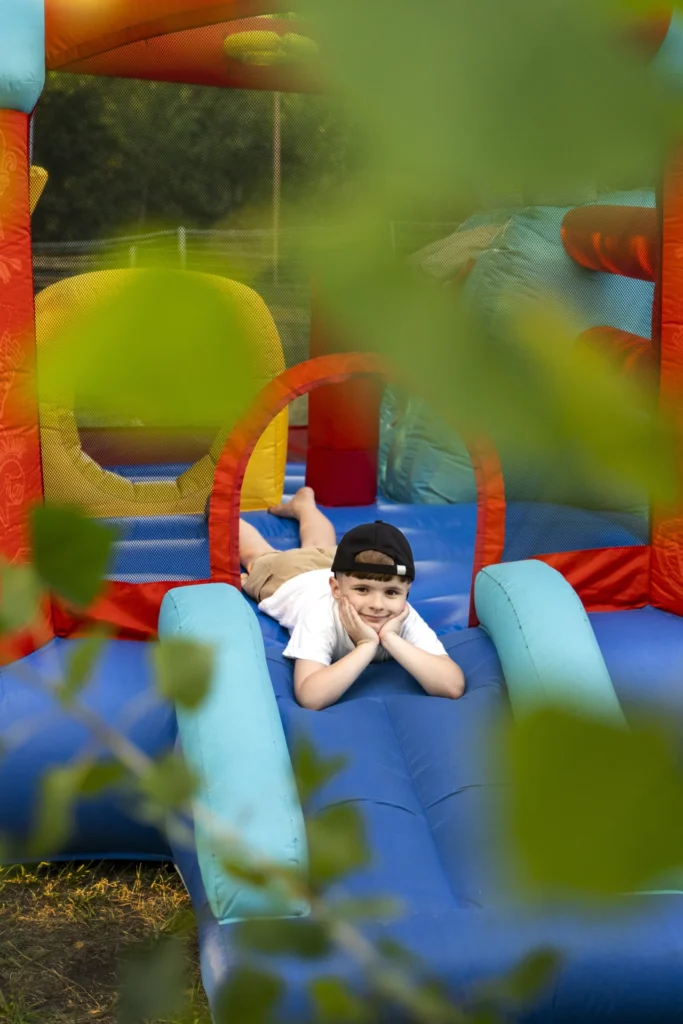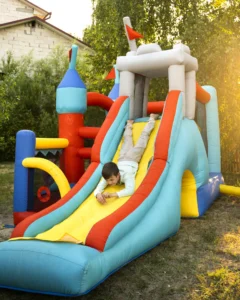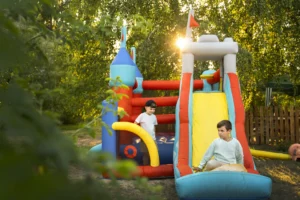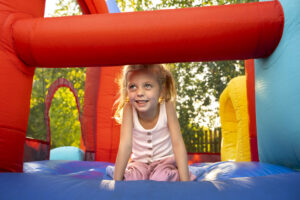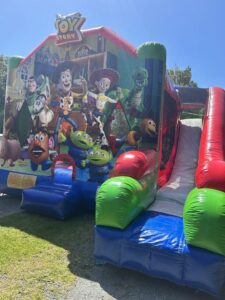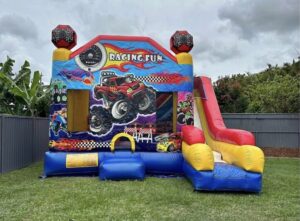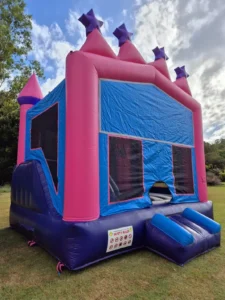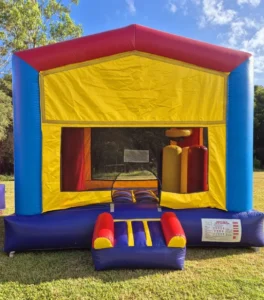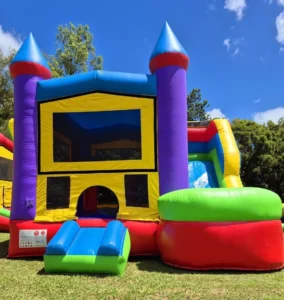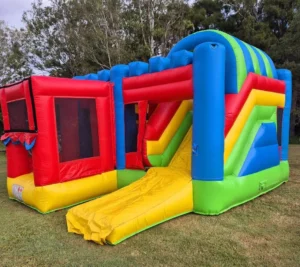Setting Up a Bounce House Made Simple
Setting up a bounce house can feel like a big job, but once you learn how to set up a bounce house step by step, you’ll see it’s simpler than it looks. Whether you call it a bounce house or a jumping castle, the fundamentals stay the same: find a safe spot, prepare your gear, and keep an eye on things while everyone enjoys some high-flying fun. Below, you’ll learn how to do it all without the usual headaches.
Pick your perfect spot
Location is half the battle when you’re getting ready to inflate. You’ll want a big, flat area, ideally around 20 feet by 20 feet, so there’s room for the blower, entrance ramp, and plenty of bounce space. Grass is often your best friend because it’s soft and allows you to anchor stakes securely. If grass isn’t an option, you can use concrete, but remember to secure your bounce house with sandbags or water weights.
A quick walk-around is worth it to remove sticks, rocks, or any sharp debris that might poke holes. According to safety guidelines, even a small slope can make the inflatable unstable, so aim for minimal incline if at all possible. Another tip: check above you as well. Make sure you have at least 20 feet of vertical clearance so you’re not bumping up against tree branches or power lines.
Gather your essential gear
Before you do any lifting, gather the things you’ll need. Most bounce houses come with the blower, stakes or anchor straps, and a tarp. The tarp can be a game-changer because it helps protect the bottom of your inflatable from wear and makes cleanup faster. You also need a dependable power source. One standard 110-volt outlet can usually handle the blower, but if your outlet is more than 100 feet away, you may need an outdoor extension cord or a generator (many rental services offer one for an extra fee).
Double-check you have enough rope or strap material to anchor your bounce house if stakes aren’t feasible. And if you’re interested in exploring other inflatable options, you could check out an inflatable bounce house or even an obstacle course for larger gatherings.
Inflate and secure carefully
When you’re ready to inflate, spread out your tarp first, then unfold the bounce house on top of it. Connect the blower tube to the blower, tightening any belts or cords so air doesn’t escape. Flip the blower switch, and let the air do its thing. Watch the house fill up, and keep an eye out for uneven inflation or any leaks.
Once the bounce house is fully inflated, you can drive in the stakes or attach the anchor straps. On concrete, use weighted bags or blocks in each of the corner tie-down loops. Make sure the straps are snug, so the bounce house doesn’t shift when kids hop around. If you notice a strong wind picking up, over about 15 mph, it’s time to deflate and store it until things calm down. Safety should always come first.
Set ground rules for safety
A bounce house may look fun and harmless, but it still calls for some clear rules and adult supervision. One adult should always be present to monitor the action. Limit the number of children and group them by age so a toddler isn’t bouncing around with older kids. The Safe Inflatable Operators Training Organization (SIOTO) suggests adults step in when rough play or flips begin. That quick intervention can prevent twisted ankles or neck strains.
Check the weather beforehand using reliable services like the National Weather Service. If storms or heavy winds roll in, deflate and pack up. And if you see lightning in the distance, it’s definitely not bounce time.
Maintain and clean easily
Once the party’s over, cleanup is straightforward if you plan for it ahead of time. Spread a tarp beneath the bounce house so dirt stays off the main surface. After everyone’s done bouncing, switch off the blower and let the house deflate. Then brush off or vacuum any debris. Wiping down high-traffic spots, like doorways or railings, with disinfectant wipes helps keep germs away, especially after a big event.
If you notice mold or stubborn dirt, consider giving it a deeper wash. A gentle solution of water, a few drops of dish soap, and a splash of vinegar is usually enough. For a full how-to, see our guide on how to clean a bounce house. Just make sure to let everything dry completely before folding it up, because moisture locked inside can breed mildew or weaken the inflatable fabric.
Sum up your final steps of how to set up a bounce house
Setting up a bounce house doesn’t have to be a chore. All it takes is choosing a flat, safe spot, anchoring properly, and keeping an eye on the fun. If you follow the tips in this guide, you’ll have a hassle-free experience every time.
Ready to Bounce? Book Your Castle Today!
Bring unforgettable joy to your next event, free delivery, easy setup, and zero deposit needed. Whether you’re planning a backyard birthday, school fair, daycare learning activities, or neighborhood party, our safe, colorful jumping castles are waiting.
Choose from popular options like our Rainbow Combo, Monster Truck Combo, or Jungle Obstacle Course for endless fun!
Serving Gold Coast, Logan & Beaudesert, plus Northern NSW with competitive delivery charges. Contact us now or submit your booking in just seconds!
Frequently asked questions
1. How to clean a bounce house?
Deflate the bounce house, sweep away debris, then wipe surfaces with mild soap and water. Rinse, disinfect high-touch areas, and let it fully air dry before storing to prevent mildew.
2.How to clean mold off a bounce house?
Mix water with gentle vinegar or bleach solution, scrub affected areas with a soft brush, then rinse thoroughly. Ensure complete drying in sunlight to stop future mold growth and material damage.
3. What is a bounce house made of?
Bounce houses are usually made of heavy-duty PVC vinyl or commercial-grade nylon. These durable, puncture-resistant materials support continuous airflow, allowing safe bouncing, sliding, and climbing during parties, events, or recreational activities.
4. Is it ok to use it in light rain?
Generally, it’s best not to. Wet surfaces can cause slips or damage the blower. If a light drizzle catches you by surprise, protect the blower, then thoroughly dry the house before the next use.
5. How to store a bounce house properly?
After cleaning and drying, fold the bounce house neatly, avoid sharp creases, and store it in a cool, dry bag. Keeping it moisture-free prevents mold, mildew, and material damage.
Key takeaways
- Choose an area with flat ground, no sharp debris, and enough overhead clearance.
- Make sure you have a stable power source or a generator.
- Anchor the bounce house well, whether it’s on grass or concrete.
- Always supervise play and follow recommended safety rules.
- Clean and dry thoroughly after each use to keep it in top shape.


